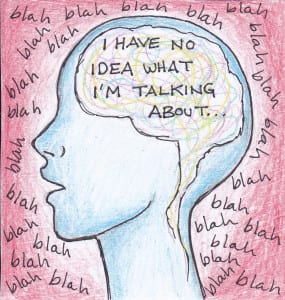 If you have attended one of my new Mental Management of Emergencies programs you have learned how stress is a game-changer when it comes to firefighter situational awareness and decision making quality. Most basic training programs focus on developing cognitive knowledge and physical skills. Far less address the impact of stress on situational awareness and decision making and the seemingly irrational (some might even term it bizarre) behaviors manifested under stress.
If you have attended one of my new Mental Management of Emergencies programs you have learned how stress is a game-changer when it comes to firefighter situational awareness and decision making quality. Most basic training programs focus on developing cognitive knowledge and physical skills. Far less address the impact of stress on situational awareness and decision making and the seemingly irrational (some might even term it bizarre) behaviors manifested under stress.
If you’re an avid viewer of the seemingly never ending supply of well-hyped ‘raw video’ from emergency scenes pervasive on the Internet, you’ve seen many examples of the irrational behavior of first responders. In this article, I’m going to address a behavior manifested, in part, by stress and it can have catastrophic consequences.
Liar Liar Pants on Fire
A powerful exercise I conduct during my Fifty Ways to Kill a First Responder program (the companion program to Mental Management of Emergencies) involves demonstrating that stress increases the propensity for humans to lie.
They don’t do it on purpose. In fact, at the start of the exercise I instruct the participants to tell the truth and avoid lying. The exercise plays out in front of a stunned audience who watch participants stand there in front of the room, and in spite of my instructions, lie to each other.
 But here’s the kicker. The participants don’t even know they’re lying. [tweet this] That’s right. Even though they are saying things that are not true, they are consciously unaware they’re doing it. The audience laughs when a participant says something outlandish. The participant laughs along with them, even though they have no idea what’s so funny.
But here’s the kicker. The participants don’t even know they’re lying. [tweet this] That’s right. Even though they are saying things that are not true, they are consciously unaware they’re doing it. The audience laughs when a participant says something outlandish. The participant laughs along with them, even though they have no idea what’s so funny.
It’s as though some of the participants are in a trance or hypnotized… something I’ve been accused of doing on occasion by will continue to deny. If we were not in the presence of friends and colleagues, this type of exercise might be a royal embarrassment for the participant.
Everyone in the room gets to see the participants lie, but no one really understands WHY they’re lying – especially when I was so emphatic in my instructions that they tell the truth. The answer to the mystery resides in the brain and its powerful need to make sense of this complex world we live in.[tweet this]
The participants in my exercise are told a story that contains about nine pieces of information, surrounded by a bunch of other words to make the sentences run coherently together (I’ll call all those unnecessary words noise). Only two or three pieces of the information are truly important but the participants don’t know which pieces of are important and which are not. So they try to remember all of them. How do they do? They fail… miserably. They are suffering from cognitive overload and their poor brains are confused.[tweet this]
Your helpful brain
What the brain does to reconcile the problem of overload can have catastrophic consequences. Like water overflowing the top of a glass, the brain starts shedding information – forgetting if you will. [tweet this] You may be surprised to learn you have about as much control over which pieces of information you’ll forget as you would have over which droplets of water run over the rim of the glass and spill on to the table.
 Our logical minds have us believing that participants will shelve the unimportant information and remember the most important information. But that’s not what happens. What does happen leaves the observers stunned. They remember the noise and forget the most important details.
Our logical minds have us believing that participants will shelve the unimportant information and remember the most important information. But that’s not what happens. What does happen leaves the observers stunned. They remember the noise and forget the most important details.
I have conducted this exercise over a hundred times and the outcome is always predictably similar. Because the human brain has a limited capacity to process and recall information, it may be no surprise that information is going to be forgotten.Observers never expect the critical information to be forgotten. But it is.
Confabulation
The second most stunning outcome of this exercise is the participants start to lie. Since lying is often associated with someone who is telling an untruth on purpose (usually to keep from getting into trouble), we think of liars as having purposeful intent to be untruthful. And since these participants are not lying on purpose, we’re uncomfortable calling it lying. Well, apparently so is the scientific community. Researchers don’t like to call it lying either so they made up their own word to describe what’s happening.
 What the participant is doing is called confabulation.[tweet this] In scientific parlance it means the participant’s brain is fabricating imaginary stories to compensate for his or her loss of memory. In layperson’s terms, you might call it making up a story – or lying.
What the participant is doing is called confabulation.[tweet this] In scientific parlance it means the participant’s brain is fabricating imaginary stories to compensate for his or her loss of memory. In layperson’s terms, you might call it making up a story – or lying.
The loss of memory comes from two sources – stress and information overload – two ingredients abundant on an emergency scene, right?
Making up stories is a safety mechanism of the brain to help you make sense of the world. [tweet this] If you lack the facts to make a story flow coherently, your brain will use imagination to fill in the missing information. It makes it up as it goes and the story will make sense to the story teller and they will be completely unaware they are confabulating. They tell the story, literally, as if it were fact.
The title of this article is You can’t handle the truth. But it should more aptly could be called: You can’t handle the information… so you make up the truth.[tweet this]
On the emergency scene
So what does this benign classroom exercise have to do with first responder safety? A lot! The same vulnerabilities of the mind played out in the classroom can manifest themselves at an emergency scene.
- Responders can think things happened that never did.[tweet this]
- Commanders can believe they gave orders that were never communicated.[tweet this]
- Responders can recount performing tasks that were never performed.[tweet this]
- Conditions can be described in ways that are inconsistent with reality.[tweet this]
Good grief! Stress and information overload makes us vulnerable creatures.
Chief Gasaway’s Advice
 It’s important to understand your vulnerabilities. Awareness of your shortcomings is the first step toward managing them. Situational awareness is an important ingredient in managing this cognitive shortcoming. Here’s why.
It’s important to understand your vulnerabilities. Awareness of your shortcomings is the first step toward managing them. Situational awareness is an important ingredient in managing this cognitive shortcoming. Here’s why.
Level 1 situational awareness is developed by a constant scanning of the environment for clues and cues (information). But not every piece of information is important. Scan and search for the most important pieces that will help with good decision making, much like you would scan a thousand pieces of a unassembled jigsaw puzzle to find the four corners.
Level 2 situational awareness is understanding the meaning of the information. Factual, timely information, in limited quantities, is key to comprehension. Volumes of information are not the friend of a stressed brain. In fact, it’s the basis for confabulation.
Level 3 situational awareness is being able to predict the future events. In order to do that, one must have an accurate understanding of the current events. Meaning, Level 3 situational awareness (SA) is built on the successful development of Level 1 SA and Level 2 SA. It all starts with capturing the right quantity and quality of information and knowing how to sift through the noise.
Discussion Questions
 1. Discuss a time when you, or someone you know, confabulated a story without realizing it was untrue.
1. Discuss a time when you, or someone you know, confabulated a story without realizing it was untrue.
2. If you are a parent (or if you aren’t, think back to when you were a kid) and discuss an example of childhood confabulation. (Remember, the motive is NOT to tell an untruth to keep from getting into trouble – that is lying!)
3. Discuss an emergency incident where you truly thought something happened or something was said in a certain way only to find out later you had confabulated.
4. Describe what happens to you when you try to process to many pieces of information at an emergency scene?
_____________________________________________________
If you are interested in taking your understanding of situational awareness and high-risk decision making to a higher level, check out the Situational Awareness Matters Online Academy.
CLICK HERE for details, enrollment options and pricing.
__________________________________
Share your comments on this article in the “Leave a Reply” box below. If you want to send me incident pictures, videos or have an idea you’d like me to research and write about, contact me. I really enjoy getting feedback and supportive messages from fellow first responders. It gives me the energy to work harder for you.
Thanks,

Email: Support@RichGasaway.com
Phone: 612-548-4424
Facebook Fan Page: www.facebook.com/SAMatters
Twitter: @SAMatters
LinkedIn: Rich Gasaway
YouTube: SAMattersTV
iTunes: SAMatters Radio


Confabulation occurs not only on the emergency scene but also in high stress/consequence administrative decisions!
Chief Connelly,
You are right on target with that observation! Thank you, sir, for the contribution.
Rich
This is very enlightening and should cause us to enter into the arena of the post incident critique more humble and open to receive the feedback that can sometimes be difficult to receive.
Hi Rich,
Another great piece. I do wish we/they in the UK would embrace your message. Particularly our firefighters.
Bill G